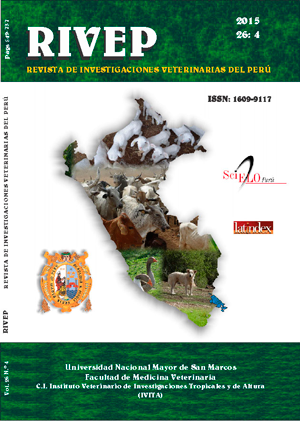Parasites and histopathological lesions in gills of juvenile gamitana (Colossoma macropomum) raised in semi-intensive farming
DOI:
https://doi.org/10.15381/rivep.v26i4.11222Keywords:
gamitana, Colossoma macropomum, monogenean, Piscinoodinium, copepod, gill ectoparasitesAbstract
The aim of this study was to determine the type and frequency of parasites in gamitana gills (Colossoma macropomum) and to describe the associated histopathological lesions. Thirty specimens were taken from a fish farm in Iquitos, Peru. The left branchial arches were placed in Petri dishes with distilled water to observe the presence of parasites and the right arches were fixed with formalin 5% for histopathological studies. Besides, water quality of the pond was analyzed. Three types of ectoparasites were identified: monogeneans, members of the Family Dactylogyridae, Subfamilies Anacanthorinae and Ancyrocephalinae (100%, 30/30), ones protozoan, member of the Family Oodinidae, genus Piscinoodinium (36.7%, 11/30), and one arthropod, member of the Class Maxillopoda, Sub-class Copepoda (20%, 6/30). Among the histopathological lesions, the most common were inflammatory disorders: presence of eosinophilic granule cells (100%), and adaptation disorders: epithelial hyperplasia (96.7%), lamellar fusion (80%) and lamellar atrophy (60%). Moreover, dissolved oxygen was close to lethal levels, pH was acid and CO2 were outside the expected range.Downloads
Downloads
Published
Issue
Section
License
Copyright (c) 2015 Mario Vargas L, Nieves Sandoval C., Eva Casas A., Gloria Pizango P., Alberto Manchego S.

This work is licensed under a Creative Commons Attribution-NonCommercial-ShareAlike 4.0 International License.
AUTHORS RETAIN THEIR RIGHTS:
a. Authors retain their trade mark rights and patent, and also on any process or procedure described in the article.
b. Authors retain their right to share, copy, distribute, perform and publicly communicate their article (eg, to place their article in an institutional repository or publish it in a book), with an acknowledgment of its initial publication in the Revista de Investigaciones Veterinarias del Perú (RIVEP).
c. Authors retain theirs right to make a subsequent publication of their work, to use the article or any part thereof (eg a compilation of his papers, lecture notes, thesis, or a book), always indicating the source of publication (the originator of the work, journal, volume, number and date).










